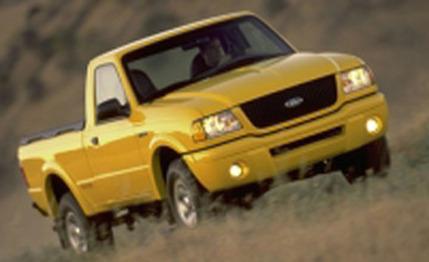
 First Drive Review
First Drive Review
Mid-model-life face lifts are routine in the car business. You know, after the initial showroom novelty has worn off, the company goes back and makes some alterations. Maybe they add a body-color grille, put on some new wheels, and slap on an interior treatment -- anything that doesn't much alter the overall mechanical architecture.
We've seen a lot of them, but Ford's freshening of the 2001 Ranger is one of the, uh, farthest-ranging exercises of the type. Most notable is the scrapping of the wimpy Splash name and replacing it with Edge. No, not The Edge, he's still playing with Bono. Just Edge, as in Ford Ranger Edge. Got it? Good. On this model, a pronounced power bulge on the hood -- necessary anyway for an optional 4.0-liter SOHC V-6 engine made available for 2001 (last year's 4.0-liter V-6 used pushrods) -- is teamed with a black honeycomb grille and body-color front bumper with incorporated push pads and driving lights.
The result is a new snarling face aimed at younger truck buyers as well as, we suspect, at paunchy midlife-crisis male trucksters hoping for a younger image. Ride height on Edge Rangers is the same hiked-up 4x4 configuration regardless of the number of wheels that can actually be driven, and the Edge also gets a molded bed rail; an easily cleaned (it says here) vinyl floor interior; a 60-watt, four-speaker, CD-player stereo system; and 15-inch wheels and 235/75R-15 tires. Also, before we forget, the familiar 3.0-liter V-6 pushrod engine with five-speed manual transmission comes as standard equipment.
Edge Rangers slot between the base model XL -- powered in standard form by a 2.5-liter in-line four -- and the high-trim-level XLT series. That 2.5-liter four-pot base engine will be replaced later this winter by a new four-cylinder engine of the same displacement derived from a family of Ford in-line engines now in development. Oh, yeah, the four is also standard equipment on XLT two-wheel-drive regular-cab models.
Because customers in the compact-truck market frequently buy base models and then add accessories, you can mix and match quite a bit. So the Ranger will be available as a regular or SuperCab (two rows of seats) model with two wheelbase choices and the option of two- or four-wheel drive with either Styleside (normal) or Flareside (kinda sporty) load beds. You got all that? Well, there's more.
The 3.0-liter V-6 is carried over and is standard on four-wheel-drive, SuperCab, and Edge models. It produces 150 horsepower at 5000 rpm and 185 pound-feet of torque at 3750 rpm. The optional new 4.0-liter SOHC V-6 has another 57 horsepower over the smaller V-6 and cranks out 238 pound-feet of torque at just 3000 rpm.
So far, so good, but in addition to all the styling and equipment variations being offered, the basic hardware had a rigorous going over, mainly in pursuit of improved refinement. The engine mounts in V-6-powered models have been retuned to reduce vibrations, and there is a new insulating blanket under the hood to cut noise.
To the same end, a laminated dash panel was adopted along with additional insulation under the instrument panel and in the flooring. The cabin benefits from expandable foams and sealers, with particular attention paid to apertures between the cabin and engine bay. The door, window, and mirror seals are all new.
The improved five-speed adaptive-shift transmission is also cited as a contributor to reducing noise in the cabin. The electronic controls of the tranny learn from driver inputs and adjust shift transitions accordingly. Thus, when the vehicle is driven in a leisurely fashion, the system upshifts earlier, holding engine speed down.
Naturally, the opposite is also true, and the transmission will shift hard and fast when instructed by a heavy right foot. As it turned out, we thought the level of shift shock was a bit too high during high-speed driving, but we were assured by a Ford engineer that it would improve as the system "learned" more. What else could he say?